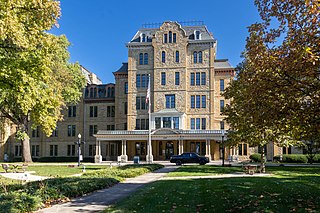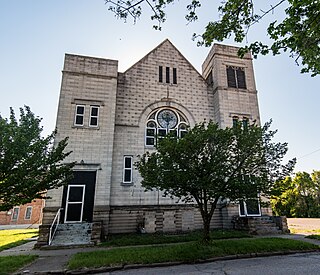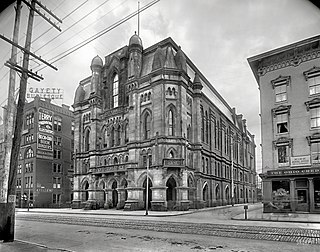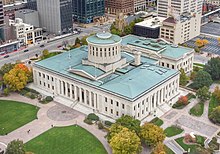
Indiana Landmarks is America's largest private statewide historic preservation organization. Founded in 1960 as Historic Landmarks Foundation of Indiana by a volunteer group of civic and business leaders led by Indianapolis pharmaceutical executive Eli Lilly, the organization is a private non-governmental organization with nearly 6,000 members and an endowment of over $40-million. The organization simplified its name to Indiana Landmarks in 2010.

Engine House No. 12 is a former fire station in the Olde Towne East neighborhood of Columbus, Ohio. Today it primarily houses Gemüt Biergarten, a German restaurant, brewery, and biergarten, with its second story used for offices. It is a contributing property to the Columbus Near East Side District, a national historic district established in 1978.

The Central Ohio Fire Museum is a firefighting museum in Downtown Columbus, Ohio. The museum is housed in the former Engine House No. 16 of the Columbus Fire Department, built in 1908. It was listed on the Columbus Register of Historic Properties in 1983 and the National Register of Historic Places in 1995.
S.G. Loewendick & Sons, also known as Loewendick Demolition Contractors, is a demolition company based in Grove City, Ohio, a suburb of Columbus. The company is the largest specializing in demolition in Central Ohio. It has torn down most of the landmark buildings in Columbus in recent decades, including Union Station, the Ohio Penitentiary, the Christopher Inn, and the Deshler Hotel.

The Ohio National Bank building is a historic structure in Downtown Columbus, Ohio. The Neoclassical building was designed by Richards, McCarty & Bulford, built in 1911, and largely remains as built. It was a long-term location for the Ohio National Bank. It was listed on the National Register of Historic Places in 1980, noted as one of the most significant examples of Greek Doric classical ornamentation in Columbus, with refined details throughout the building.

Columbus Public Health is the health department of Columbus, Ohio. The department is accredited by the Public Health Accreditation Board. The department dates to 1833, when the city's mayor appointed five citizens to help with its cholera outbreak. It became a permanent body to activate whenever health emergencies arose.

Budd Dairy Food Hall is a food hall in the Italian Village neighborhood of Columbus, Ohio. The Cameron Mitchell Restaurants-run hall holds ten foodservice locations, three bars, and indoor, patio, and rooftop seating. It is situated in the historic Budd Dairy Company building, a former milk processing and distribution facility. The space was renovated beginning in 2018, and opened in April 2021.

The West Side Spiritualist Church was a historic church building in Franklinton, Columbus, Ohio. The Spiritualist church was built in 1912 for the congregation of Harry Boerstler, who moved to the neighborhood in 1900 to bring hope to its working-class people. The congregation lasted until about 1948, and the building later housed the Boerstler Memorial Spiritualist Temple and the Greater Christ Temple Apostolic Church. After years of vacancy, the church building was approved to be demolished for affordable housing, to accompany an upscale mixed-use development nearby, despite opposition from preservationists.

David Riebel was a German-American architect in Columbus, Ohio. He was the head architect for the Columbus public school district from 1893 to 1922. In 1915, The Ohio Architect, Engineer and Builder considered his firm, David Riebel & Sons, to be the oldest and among the best architects in Columbus.

The Union Station arch is a 35 ft (11 m) Beaux-Arts arch standing at McFerson Commons Park in Columbus, Ohio. The work was designed by renowned architect Daniel Burnham, as part of a grand entranceway to the city's Union Station. It has intricate details, including Corinthian columns, multiple cornices and friezes, and statuary groups; some currently in storage.

The Alfred Kelley mansion was a historic house in Downtown Columbus, Ohio. It was the home of Alfred Kelley, built in 1838. The house stayed in the family for decades, and was later an Ohio governor's mansion, and further on, a Catholic school. It was abandoned in the 1950s, and was deconstructed in 1961 in order to build the Christopher Inn. A preservation committee tried to move and rebuild the house; after years and several moves, the stone remnants were placed at the Hale Farm and Village near Akron in 1973, where they remain today.

The Columbus Bus Station was an intercity bus station in Downtown Columbus, Ohio. The station, managed by Greyhound Lines, also served Barons Bus Lines, Miller Transportation, GoBus, and other carriers. The current building was constructed in 1969. From 1979 until its closure in 2022, with the demolition of Union Station and a short-lived replacement, the Greyhound station was the only intercity transit center in the city.

Columbus City Hall was the city hall for Columbus, Ohio, located on Capitol Square in the city's downtown. The building served the mayor and city council from its construction in 1872 until its demolition in 1921. The building was the founding site for the United Mine Workers of America in 1890. In 1928, the site became home to the Ohio Theatre, and the current Columbus City Hall opened nearby.

The Ohio Institution for the Deaf and Dumb was a deaf school campus in Downtown Columbus, Ohio. The school, today known as the Ohio School for the Deaf, sat on the present-day Topiary Park grounds in the modern-day Discovery District. The main school building was gutted by a fire on October 2, 1981, though an existing building still stands as Cristo Rey Columbus High School. That remaining building is listed on the National Register of Historic Places and Columbus Register of Historic Properties.

Engine House No. 7 is a former Columbus Fire Department station in the Weinland Park neighborhood of Columbus, Ohio. It was built in 1888 and was listed on the Columbus Register of Historic Properties in 1994. Today the building houses a local branch of the Communications Workers of America, Local 4501.

Engine House No. 10 is a Columbus Division of Fire station in the Franklinton neighborhood of Columbus, Ohio. The original firehouse was built in 1897, while its neighboring replacement, also known as Station 10, was completed in 2008.

The Lazarus House is a historic house in Downtown Columbus, Ohio. It was built in 1886 for Frederick Lazarus Sr., president of the F&R Lazarus & Company, and was designed in the French Second Empire style. It has undergone numerous renovations since its construction, including for conversion into office space, into apartments, and back to predominantly single-family occupancy. The house is a contributing property of the East Town Street Historic District, on the National Register of Historic Places and Columbus Register of Historic Properties.
Nagy Brothers Shoe Repair is a historic building in the Hungarian Village neighborhood of Columbus, Ohio. The one-story structure was built in 1932 in a vernacular commercial style. The building was historically used as a shoe repair shop and gas station.

The Columbus Public School Library was a two-story building in Downtown Columbus, Ohio. It operated as the school library and administrative offices for the Columbus Public School District from 1892 to 1912. The library was established in the former First Methodist Episcopal Church, built in 1853 and extensively renovated for the district's use. The library opened in April 1892 and its ceiling collapsed in September 1912, leading to the building's demolition in 1913.

Engine House No. 8, also known as the Twentieth Street Engine House, is a former Columbus Fire Department station in the Mount Vernon neighborhood of Columbus, Ohio. The building was constructed in 1888, designed in the Romanesque Revival style. The station was decommissioned in 1968. In the 1980s, a supermarket was built around the original structure; today the firehouse and supermarket buildings are used as the Franklin County Department of Job and Family Services' East Opportunity Center.

























